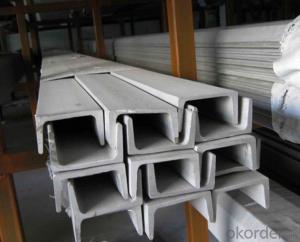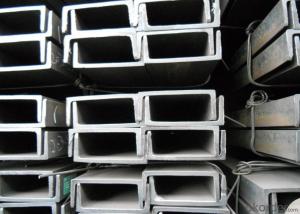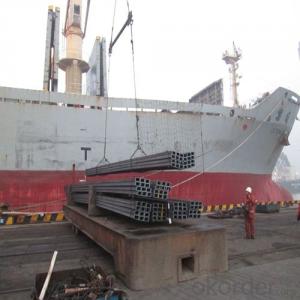GB U Channel 50MM-300MM High Quality Hot Rolled
- Loading Port:
- Tianjin
- Payment Terms:
- TT or LC
- Min Order Qty:
- 25 m.t.
- Supply Capability:
- 20000 m.t./month
OKorder Service Pledge
OKorder Financial Service
You Might Also Like
Product Description:
OKorder is offering high quality Hot Rolled Steel I-Beams at great prices with worldwide shipping. Our supplier is a world-class manufacturer of steel, with our products utilized the world over. OKorder annually supplies products to European, North American and Asian markets. We provide quotations within 24 hours of receiving an inquiry and guarantee competitive prices.
Product Applications:
According to the needs of different structures, Angle can compose to different force support component, and also can be the connections between components. It is widely used in various building structures and engineering structures such as roof beams, bridges, transmission towers, hoisting machinery and transport machinery, ships, industrial furnaces, reaction tower, container frame and warehouse etc
Product Advantages:
OKorder's Steel I-Beams are durable, strong, and resist corrosion.
Main Product Features:
· Premium quality
· Prompt delivery & seaworthy packing (30 days after receiving deposit)
· Corrosion resistance
· Can be recycled and reused
· Mill test certification
· Professional Service
· Competitive pricing
Product Specifications:
Manufacture: Hot rolled
Grade: Q195 – 235
Certificates: ISO, SGS, BV, CIQ
Length: 6m – 12m, as per customer request
Packaging: Export packing, nude packing, bundled
Sizes: 25mm-250mm | ||
a*t | ||
25*2.5-4.0 | 70*6.0-9.0 | 130*9.0-15 |
30*2.5-6.6 | 75*6.0-9.0 | 140*10-14 |
36*3.0-5.0 | 80*5.0-10 | 150*10-20 |
38*2.3-6.0 | 90*7.0-10 | 160*10-16 |
40*3.0-5.0 | 100*6.0-12 | 175*12-15 |
45*4.0-6.0 | 110*8.0-10 | 180*12-18 |
50*4.0-6.0 | 120*6.0-15 | 200*14-25 |
60*4.0-8.0 | 125*8.0-14 | 250*25 |
FAQ:
Q1: How do we guarantee the quality of our products?
A1: We have established an advanced quality management system which conducts strict quality tests at every step, from raw materials to the final product. At the same time, we provide extensive follow-up service assurances as required.
Q2: How soon can we receive the product after purchase?
A2: Within three days of placing an order, we will begin production. The specific shipping date is dependent upon international and government factors, but is typically 7 to 10 workdays.
Q3: What makes stainless steel stainless?
A3: Stainless steel must contain at least 10.5 % chromium. It is this element that reacts with the oxygen in the air to form a complex chrome-oxide surface layer that is invisible but strong enough to prevent further oxygen from "staining" (rusting) the surface. Higher levels of chromium and the addition of other alloying elements such as nickel and molybdenum enhance this surface layer and improve the corrosion resistance of the stainless material.
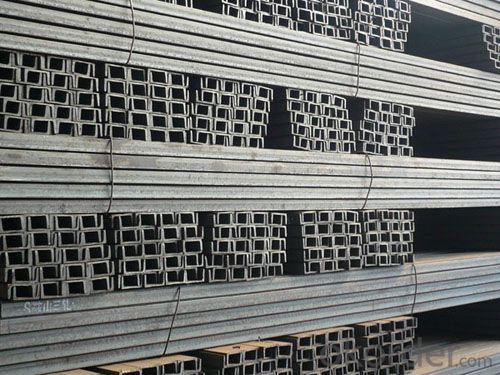
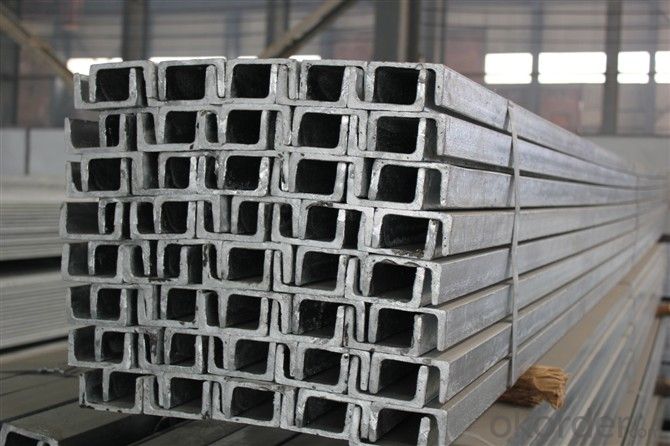

- Q:Can steel channels be used for conveyor supports?
- Yes, steel channels can be used for conveyor supports. Steel channels are often chosen for their strength and durability, making them suitable for supporting conveyor systems that carry heavy loads.
- Q:What is the maximum load-bearing capacity of channel 12M span 100?
- Maximum load-bearing capacity of channel steel with span 12M 100 can be obtained by calculation.Suppose the channel material is Q235, model 10, vertical and 12M, center force, and the maximum load is P. First check the manual to get yield stress 235MPa, then check the channel manual to get the bending coefficient of 80.5, multiply the two, and get the bending moment of 18917.5Nm.
- Q:What are the different corrosion protection methods for steel channels in marine environments?
- Steel channels in marine environments face a high risk of corrosion due to the presence of saltwater and harsh elements. To protect against corrosion, there are several methods available: 1. Coating: Applying protective coatings, such as epoxy, polyurethane, and zinc-rich paints, creates a barrier between the steel surface and corrosive elements. This prevents direct contact and subsequent corrosion. 2. Cathodic protection: This method utilizes sacrificial anodes or impressed current to safeguard steel channels. Sacrificial anodes made of zinc or aluminum are attached to the steel channels and corrode preferentially, sacrificing themselves to protect the steel. Impressed current systems use an external power source to provide a protective electrical current. 3. Galvanization: Galvanizing steel channels involves coating them with a layer of zinc, which acts as a sacrificial layer. This sacrificial layer corrodes instead of the steel, providing protection against corrosion in marine environments. 4. Stainless steel: Utilizing stainless steel channels is another effective method. Stainless steel contains chromium, which forms a passive oxide layer on the surface, safeguarding against corrosion. It is highly resistant to corrosion in marine environments and commonly used in critical applications. 5. Proper maintenance: Regular inspection, maintenance, and upkeep are crucial to prevent corrosion in steel channels. This includes removing marine growth, repairing coating damage, and ensuring proper drainage and ventilation to minimize exposure to corrosive elements. It is important to consider factors such as the severity of the marine environment, duration of exposure, and expected lifespan of the steel channels when selecting a corrosion protection method. Consulting corrosion engineers or specialists can assist in determining the most suitable protection method for specific marine applications.
- Q:Can steel channels be used in agricultural buildings?
- Yes, steel channels can be used in agricultural buildings. They provide structural support and durability, making them suitable for various applications such as framing, support beams, and roof trusses in agricultural structures.
- Q:Can steel channels be used in temporary structures?
- Yes, steel channels can be used in temporary structures. Steel channels are commonly used in construction for their strength and durability. They are versatile and can be easily assembled and disassembled, making them suitable for temporary structures. Steel channels can provide structural support and stability, making them ideal for applications such as temporary bridges, scaffolding, and shoring systems. Additionally, steel channels can withstand various weather conditions and are resistant to corrosion, making them a reliable choice for temporary structures that may be exposed to the elements.
- Q:Can steel channels be used for supporting suspended ceilings?
- Yes, steel channels can be used for supporting suspended ceilings. Steel channels are commonly used in construction as they provide strength and stability for various structural applications, including supporting suspended ceilings. They offer durability and can withstand the weight of the suspended ceiling materials, ensuring a secure and long-lasting installation.
- Q:How are steel channels connected to other structural members?
- Various methods are commonly used to connect steel channels to other structural members. One prevalent approach involves welding, where electric arc welding or other welding techniques are employed to weld the channels to other steel members. This welding process ensures a robust and permanent connection between the channels and the other members. Another method involves bolting. By using bolts, nuts, and washers, steel channels can be easily bolted to other members. This method allows for convenient disassembly and reassembly when necessary, making it suitable for specific applications. Rivets can also be used to connect steel channels in certain cases. This technique entails drilling holes through both the channels and the other members, and then inserting rivets into these holes. The rivets are then hammered or pressed to secure the connection. Although riveting provides a durable and reliable connection, it can be time-consuming and requires skilled labor. Moreover, mechanical connectors such as steel plates, brackets, or cleats can be utilized to connect steel channels to other members. These connectors are typically bolted or welded to both the channel and the other member, creating a strong and stable connection. Ultimately, the choice of connecting method for steel channels depends on project-specific requirements, the necessary load-bearing capacity, and the desired level of durability. Structural engineers and steel fabricators carefully consider these factors to determine the most suitable method for each application.
- Q:How do steel channels hold up against extreme temperatures?
- Steel channels are renowned for their exceptional strength and durability, rendering them highly capable of enduring extreme temperatures. The unique properties of steel, including its high melting point and thermal conductivity, enable steel channels to retain their structural integrity even in the face of extreme heat or cold. When subjected to high temperatures, steel channels exhibit a slower rate of expansion compared to other materials, thereby minimizing the risk of deformation or failure. This resistance to thermal expansion stems from the low coefficient of linear expansion inherent in steel. This property ensures that steel channels retain their shape and structural stability even amidst drastic temperature fluctuations. Moreover, steel channels boast excellent fire resistance. Steel possesses a high melting point, typically ranging from 1370°C to 1530°C (2500°F to 2800°F), thereby allowing it to withstand intense heat without compromising its structural integrity. Consequently, steel channels emerge as a dependable choice in applications where fire protection holds utmost importance, such as in buildings, bridges, or industrial structures. Conversely, steel also exhibits commendable performance in cold temperatures. Unlike certain materials that become brittle or weak when exposed to low temperatures, steel maintains its strength and ductility. Consequently, steel channels prove suitable for utilization in environments characterized by extremely cold temperatures, such as in arctic regions or cryogenic facilities. In conclusion, steel channels exhibit remarkable resilience to extreme temperatures owing to their low coefficient of linear expansion, high melting point, and overall durability. Regardless of exposure to intense heat or cold, steel channels retain their structural integrity and deliver long-lasting performance, thereby positioning themselves as a dependable choice in diverse applications.
- Q:Can steel channels be used for structural support?
- Yes, steel channels can be used for structural support. Steel channels have excellent strength and load-bearing capabilities, making them suitable for various structural applications such as supporting beams, columns, and frameworks in buildings, bridges, and other infrastructure projects.
- Q:Are steel channels available in non-standard sizes?
- Yes, steel channels are available in non-standard sizes.
1. Manufacturer Overview |
|
|---|---|
| Location | |
| Year Established | |
| Annual Output Value | |
| Main Markets | |
| Company Certifications | |
2. Manufacturer Certificates |
|
|---|---|
| a) Certification Name | |
| Range | |
| Reference | |
| Validity Period | |
3. Manufacturer Capability |
|
|---|---|
| a)Trade Capacity | |
| Nearest Port | |
| Export Percentage | |
| No.of Employees in Trade Department | |
| Language Spoken: | |
| b)Factory Information | |
| Factory Size: | |
| No. of Production Lines | |
| Contract Manufacturing | |
| Product Price Range | |
Send your message to us
GB U Channel 50MM-300MM High Quality Hot Rolled
- Loading Port:
- Tianjin
- Payment Terms:
- TT or LC
- Min Order Qty:
- 25 m.t.
- Supply Capability:
- 20000 m.t./month
OKorder Service Pledge
OKorder Financial Service
Similar products
New products
Hot products
Hot Searches
Related keywords
